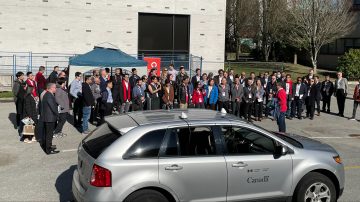
In 2018, UBC launched a national testbed for connected-vehicle research as part of an initiative to promote safe, smart transportation in BC and beyond. The facility, called AURORA (AUtomotive testbed for Reconfigurable and Optimized Radio Access), includes a testbed management centre, a mobile base station and eleven intersections equipped with roadside units at UBC’s Vancouver campus. It also includes traffic cameras, software-defined radios, a smart traffic signal controller and two test drive vehicles, with all units connected to the campus network by wireless links.
Lead researcher Professor Dave Michelson of Electrical and Computer Engineering emphasized that the goal of the effort is to “enhance information sharing between vehicles, infrastructure and pedestrians, to improve safety and get people to their destination more efficiently.” The research would be facilitated by partnerships among academia, industry, and government in an integrated world-class facility.
The advent of 5G and the UBC-Rogers partnership on 5G research and innovation created an opportunity to greatly accelerate this connected vehicle research, leveraging the speed and capacity of emerging 5G standards to handle the data communications. Rogers’ extensive infrastructure and partnership network enabled expansion of the scope of the research and its potential applications, including emergency vehicle prioritization. The new Smart Transportation Research Intersection located behind the AMPEL building is part of this expansion.
On Tuesday, March 28, during the ITSC-UBC-IEEE ITS Technology Innovation Forum, over 130 provincial and municipal transportation engineers and suppliers attended the opening of the new Research Intersection. Attendees had the opportunity to view six of the testbeds comprising the site, including the Smart Portable Traffic Signal, the 5G Performance Testbed, the GNSS Performance Testbed, the Interference Detection Testbed, the Probe Vehicle Testbed, and the Traffic Optimization Testbed powered by Rogers business partner NoTraffic. All of these testbeds were developed in collaboration with Rogers. Graduate students Hamed Noori, Xin Chen, Ruizhan Shen, and Berkay Talha Acar, and capstone students Sam Gu, Ting Xu, Vinnie Weining Wu, Dylan Painter, Rutendo Musuka, and Harmeeta Dahiya, served as presenters.
Funded by the CFI and inspired by facilities at the University of California-Berkeley’s Richmond Field Station, UBC’s Research Intersection can support a variety of teaching and research activities concerning intelligent transportation and connected vehicles that cannot be performed at a public intersection for safety and other reasons.
This research addresses key industry challenges like GPS reliability, using 5G millimetre-wave in ITS applications, interference detection and reporting, development of efficient systems for collecting and interpreting probe vehicle data, application of vehicular trajectory data to ITS decision making, and traffic signal optimization.
The outcomes of this research are making ITS more effective and reliable; in some cases, such as the work on interference detection and reporting in ITS environments, it is truly world leading.
With facilities and connections required to pursue serious ITS research and development, including both live and off-road intersections equipped with state-of-the-art infrastructure, UBC now has the capacity to host sessions for those who wish to take a closer look at, and gain hands-on experience with, specific technologies.